drown
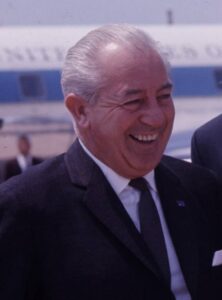
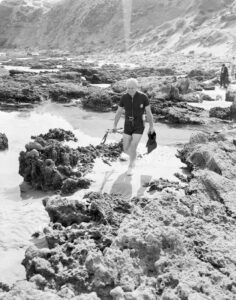 When someone goes missing, it leaves a number of people at a standstill, so to speak. At first, they think they can find the person quickly, but then, if the ordeal carries on for a while, they begin to lose hope of ever seeing their loved one again. When the missing person is someone of prominence, the case goes very public, very quickly, and while that could help find the person, it also puts a negative connotation on the situation.
When someone goes missing, it leaves a number of people at a standstill, so to speak. At first, they think they can find the person quickly, but then, if the ordeal carries on for a while, they begin to lose hope of ever seeing their loved one again. When the missing person is someone of prominence, the case goes very public, very quickly, and while that could help find the person, it also puts a negative connotation on the situation.
On December 17, 1967, in what turned out to be an unsolved missing person case, Harold Edward Holt, who was Australia’s 17th Prime Minister and a member of parliament for 32 years, disappeared during his first term in office as Prime Minister. He was never found, and the case remains unsolved to this day. That December 17th was a Sunday morning. Holt decided to drive down to Melbourne with friends and bodyguards to see British Yachtsman Alec Rose sail through port. The plan was to watch the yacht go through, and then head down to Holt’s favorite swimming and snorkeling spot at Cheviot Beach, east of Port Phillip Bay. While there, Holt decided to take a swim. Holt went down to the water, which has notoriously strong currents and rip tides. Soon after going in, Holt disappeared from view and the situation quickly escalated into one of Australia’s largest search operations ever, but the search was in vain, and Holt was never found.
Now, this might seem like a simple case of drowning, but with no body found, there is always room for speculation as to the “real” reason for his disappearance. People began to speculate that he was caught in strong currents and then dragged underwater and whisked further out to sea. That would be the most logical cause of his disappearance, but it was also speculated that he may have faked his own death to run off with his mistress. It seems strange that he would walk away from his sons too, but you never know.
Holt was born on August 5, 1908, at his parents’ home in Stanmore, New South Wales, a suburb of Sydney. He was the first of two sons born to Olive May (née Williams; formerly Pearce) and Thomas James Holt. In 1927, Holt began studying law at the University of Melbourne, while living at Queen’s College on a scholarship. He represented the university in cricket and football, and was also active in various student organizations, serving as president of the Law Students’ Society and of the Queen’s College Social Club. Holt won prizes for oratory and essay-writing and was a member of the inter-university debating team. He graduated with a Bachelor of Laws degree in 1930. Holt’s father, who was living in London, invited him to continue his studies in England, but he declined the offer. Holt served his articles of clerkship with the firm of Fink, Best, and Miller. He was admitted to the Victorian Bar in late 1932 and opened his own legal practice the following year. Unfortunately, the Depression brought with it few clients, and he was frequently underpaid. During those years, he lived in a boardinghouse and often relied upon the hospitality of friends. It was this time in his life that made him consider politics. Holt married Zara Dickins, the daughter of a Melbourne businessman, after an on 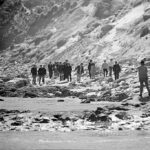
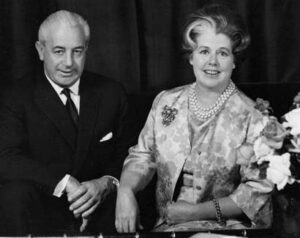 again off again, relationship, and her first marriage to James Fell, a British Indian Army officer. He later adopted her three children, and many people thought he was probably the biological father of her twins, Sam and Adrew, who look a lot like Holt. She also had an older son named Nicholas, whom Holt adopted as well. After his presumed drowning, Zara Holt said that he had been involved in a number of extramarital affairs, sparking the idea that maybe he wasn’t really dead. I doubt we will ever know. A memorial service was held on December 22nd, at St Paul’s Cathedral, Melbourne.
again off again, relationship, and her first marriage to James Fell, a British Indian Army officer. He later adopted her three children, and many people thought he was probably the biological father of her twins, Sam and Adrew, who look a lot like Holt. She also had an older son named Nicholas, whom Holt adopted as well. After his presumed drowning, Zara Holt said that he had been involved in a number of extramarital affairs, sparking the idea that maybe he wasn’t really dead. I doubt we will ever know. A memorial service was held on December 22nd, at St Paul’s Cathedral, Melbourne.
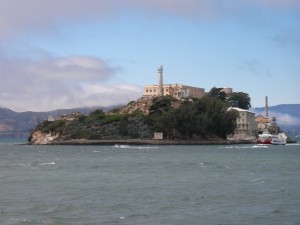 Sometimes, it has to be accepted that just maybe, something is impossible. Still, when a challenge seems impossible, there is always someone who comes along and proves that it can be done. Alcatraz island, and the prison that is located there were known to be impossible to escape from. Over the years that Alcatraz was open, there were 14 escape attempts. Myths and mysteries surrounded Alcatraz, and it’s seemingly inescapable water fortress for years. One of the many myths about Alcatraz is that it was impossible to survive a swim from the island to the mainland because of sharks. In fact, there are no “man-eating” sharks in San Francisco Bay, only small bottom-feeding sharks. The real obstacles the prisoners faced were the cold temperatures…which averaged 50 to 55 degrees Fahrenheit, the strong currents in the water, and the distance to shore, which was at least 1¼ miles. Those things combined were known to have bested most people who attempted to make it from Alcatraz to San Francisco.
Sometimes, it has to be accepted that just maybe, something is impossible. Still, when a challenge seems impossible, there is always someone who comes along and proves that it can be done. Alcatraz island, and the prison that is located there were known to be impossible to escape from. Over the years that Alcatraz was open, there were 14 escape attempts. Myths and mysteries surrounded Alcatraz, and it’s seemingly inescapable water fortress for years. One of the many myths about Alcatraz is that it was impossible to survive a swim from the island to the mainland because of sharks. In fact, there are no “man-eating” sharks in San Francisco Bay, only small bottom-feeding sharks. The real obstacles the prisoners faced were the cold temperatures…which averaged 50 to 55 degrees Fahrenheit, the strong currents in the water, and the distance to shore, which was at least 1¼ miles. Those things combined were known to have bested most people who attempted to make it from Alcatraz to San Francisco.
The prisoners tried every possible escape plan they could think of…from simply climbing over a fence to the most elaborate attempt which was made famous by the movie “Escape From Alcatraz,” when on June 11, 1962, 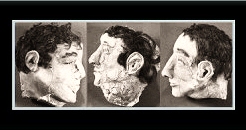 Frank Morris, and brothers John and Clarence Anglin cut through the walls, and made false walls to conceal their work, then placing “dummy heads” in their beds, so they would have all night to make their escape. Using raincoats turned into floatation devises, they made their escape. A cell house search turned up the drills, heads, wall segments, and other tools, while the water search found two life vests…one in the bay, the other outside the Golden Gate, oars, as well as letters and photographs belonging to the Anglins that had been carefully wrapped to be watertight. No sign of the men was found. Several weeks later a man’s body dressed in blue clothing similar to the prison uniform was found a short distance up the coast from San Francisco, but the body was too badly deteriorated to be identified. Speculation continues to this day as to whether or not the other two made it to safety.
Frank Morris, and brothers John and Clarence Anglin cut through the walls, and made false walls to conceal their work, then placing “dummy heads” in their beds, so they would have all night to make their escape. Using raincoats turned into floatation devises, they made their escape. A cell house search turned up the drills, heads, wall segments, and other tools, while the water search found two life vests…one in the bay, the other outside the Golden Gate, oars, as well as letters and photographs belonging to the Anglins that had been carefully wrapped to be watertight. No sign of the men was found. Several weeks later a man’s body dressed in blue clothing similar to the prison uniform was found a short distance up the coast from San Francisco, but the body was too badly deteriorated to be identified. Speculation continues to this day as to whether or not the other two made it to safety.
The official statement says they drown, and while it is likely that they did, it has been proven that it was indeed possible to swim from Alcatraz to San Francisco. Prior to the Federal institution opening in 1934, a teenage girl swam to the island to prove it was possible. Fitness guru Jack LaLanne swam to the island pulling a rowboat, 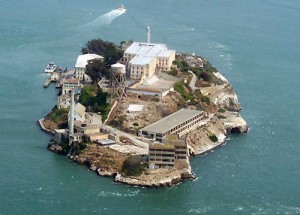 and several years ago two 10 year old children also made the swim. The official stand on that is that if a “person is well trained and conditioned, it is possible to survive the cold waters and fast currents. However, for prisoners, who had no control over their diet, no weightlifting or physical training (other than situps and pushups), and no knowledge of high and low tides, the odds for success were slim.” As to the escape attempts in which no body was ever found, we will never really know if they somehow managed to beat the odds and went on to live a quiet life under an assumed name or if they were swept away to be basically buried at sea. Either way, it is a very interesting subject to speculate on. I personally think that at least one of the three men made it.
and several years ago two 10 year old children also made the swim. The official stand on that is that if a “person is well trained and conditioned, it is possible to survive the cold waters and fast currents. However, for prisoners, who had no control over their diet, no weightlifting or physical training (other than situps and pushups), and no knowledge of high and low tides, the odds for success were slim.” As to the escape attempts in which no body was ever found, we will never really know if they somehow managed to beat the odds and went on to live a quiet life under an assumed name or if they were swept away to be basically buried at sea. Either way, it is a very interesting subject to speculate on. I personally think that at least one of the three men made it.
 Anytime a nation’s leader is killed, it’s a disaster, no matter how they died, but it is not so common for the disaster to still be felt when their child is killed, although the nation naturally feels a degree of collective sadness. In a monarchy, however, things are different. The child of the current king stands to be the next leader. These days, having a girl be the next in line for the throne is not a problem, in most nations, but that was not the case in England in 1120. At the time, the king of England was King Henry I. The Norman dynasty had not been in power very long, and the King Henry I was very eager to have the line continue on. His problem was solved with the birth of his only legitimate son, William the Aethling, who was called by the Saxon princely title to stress that his parents had united both Saxon and Norman Royal Houses. William was a warrior prince who, even at the age of seventeen, fought alongside his father to reassert their rights in their Norman lands on the Continent. As was common with kings, especially in that era, and maybe not so unusual in this era, the king had multiple concubines, and so several illegitimate children too. He did have a legitimate daughter named Matilda, but the throne belonged to his son. His illegitimate children were Richard, and oddly, a second Matilda. All seemed right in his world.
Anytime a nation’s leader is killed, it’s a disaster, no matter how they died, but it is not so common for the disaster to still be felt when their child is killed, although the nation naturally feels a degree of collective sadness. In a monarchy, however, things are different. The child of the current king stands to be the next leader. These days, having a girl be the next in line for the throne is not a problem, in most nations, but that was not the case in England in 1120. At the time, the king of England was King Henry I. The Norman dynasty had not been in power very long, and the King Henry I was very eager to have the line continue on. His problem was solved with the birth of his only legitimate son, William the Aethling, who was called by the Saxon princely title to stress that his parents had united both Saxon and Norman Royal Houses. William was a warrior prince who, even at the age of seventeen, fought alongside his father to reassert their rights in their Norman lands on the Continent. As was common with kings, especially in that era, and maybe not so unusual in this era, the king had multiple concubines, and so several illegitimate children too. He did have a legitimate daughter named Matilda, but the throne belonged to his son. His illegitimate children were Richard, and oddly, a second Matilda. All seemed right in his world.
King Henry I was king from August 2, 1100, until his death on December 1, 1135, and expected that his son, Prince William would take his place as king upon his death. Then disaster struck on the November 25, 1120. This was a disaster that would have a dramatic effect, not only on the families of those involved, but on the very fabric of English Government. After a successful battle in 1119, which brought the defeat of King Louis IV of France, and the humiliation at the Battle of Brémule, the King and his entourage were headed home to celebrate. The king was offered a fine ship, the White Ship to travel home in, but he declined because he had already made other arrangements. He suggested that his son and some of the other men could talk the journey on the White Ship.
As the heir to the throne, Prince William attracted the cream of society to surround him. His entourage was to include some three hundred fellow passengers…140 knights and 18 noblewomen, his half-brother, Richard, his half-sister, Matilda the Countess of Perche; his cousins, Stephen and Matilda of Blois, the nephew of the German Emperor Henry V, the young Earl of Chester and most of the heirs to the great estates of England and Normandy. The passengers were all in a mood to celebrate, and asked the Prince for drinks. The prince had brought wine aboard the ship by the barrel-load to help with the festivities. Before long the both passengers and crew became highly intoxicated. Some even left the shop when things started getting abusive.
The people who remained were drunk, and decided that it would be a great idea to try to catch the ship the king was on. The king’s ship had already sailed out into the English Channel.  The people kept pushing the captain to accept the challenge. The captain was sure that his ship could catch the king’s ship, so they set out that evening, and immediately struck a rock in the channel as they left. The ship began to sink, and Prince William was safely in a boat, but he heard his half-sister, Matilda screaming for help. So he left the boat to rescue her. The boat he was in was hit by a group of desparate passengers, and swamped. Prince William was lost and drown. The nation was devastated, and when King Henry I tried to get them to accept his legitimate daughter, Matilda, but they didn’t want to and when the king died, Matilda and her husband found themselves fighting for the throne in a war known as The Anarchy.
The people kept pushing the captain to accept the challenge. The captain was sure that his ship could catch the king’s ship, so they set out that evening, and immediately struck a rock in the channel as they left. The ship began to sink, and Prince William was safely in a boat, but he heard his half-sister, Matilda screaming for help. So he left the boat to rescue her. The boat he was in was hit by a group of desparate passengers, and swamped. Prince William was lost and drown. The nation was devastated, and when King Henry I tried to get them to accept his legitimate daughter, Matilda, but they didn’t want to and when the king died, Matilda and her husband found themselves fighting for the throne in a war known as The Anarchy.

